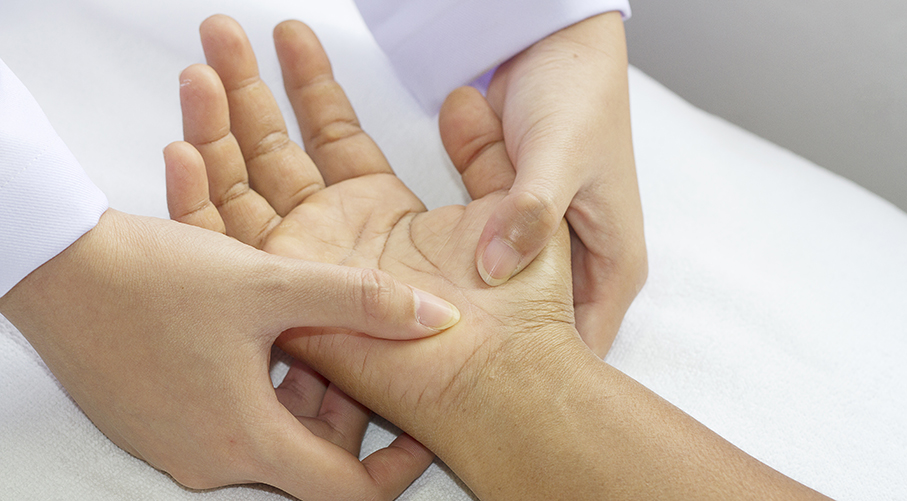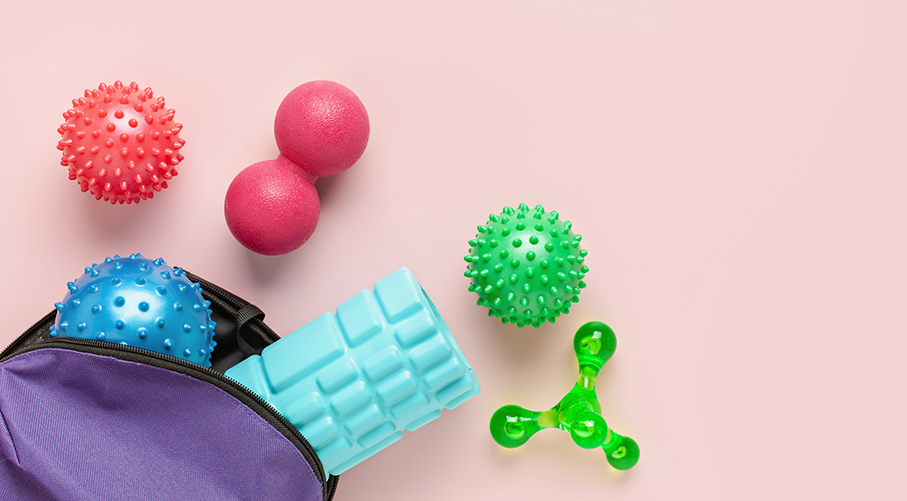Is there a simple technique that will enhance performance, improve range of motion, and reduce pain i my hands?
As part of a therapeutic session with the caring Hand Therapists at CHARMS, they may incorporate Trigger Point Release. Used alongside therapeutic heat, strengthening, and stretching exercises, Trigger Point Release improves circulation and relieves muscle tightness. This actively improves range of motion, enhances performance, and reduces symptoms of pain.

Overview
What Are Trigger Points?
Trigger points are small nodules or knots in our muscles. Often, they are tender, hyperirritable, or painful. They can also refer pain to other parts of the body. Many parts of the body are susceptible to developing trigger points such as the neck and shoulders. Trigger points may also form in the delicate and complex muscle structures in our hands, wrists, and forearms. These can limit range of motion, reduce hand and wrist function, and cause symptoms of pain and discomfort.
Video Suggestion:
How are Trigger Points Diagnosed?
Your Hand Therapist at CHARMS may investigate for the presence of trigger points during a basic screening. An example would be if active movement of one patient’s hand is reduced compared to the other hand. This might suggest tightness of muscles and the presence of muscle knots or trigger points. The physical finding of a trigger point is palpation of a hypersensitive bundle or nodule of muscle fibres that is harder than normal.
Overview of Symptoms and Possible Cause
Patients will present with persistent pain in a localised region of the hand or wrist that results in reduced performance and decreased range of motion in the affected muscles. Trigger points can limit blood supply and nerve function. This may cause sensations of numbness and tingling. Sometimes, trigger points are painless, and pain can also be referred to other parts of the hand or wrist.
The possible causes of trigger points are wide ranging. Acute trauma or overloading the muscles of the hands, wrists, and forearms may cause the development of trigger points. Repetitive strain or microtrauma on our dexterous muscles could bring about stress to the muscle fibres and the subsequent formation of trigger points.
What Happens During Trigger Point Release?
Trigger point release actively reduces muscle tightness which improves blood circulation and helps to decompress corresponding nerves. This improves range of motion while enhancing sports and activity performance. Interestingly, of the ten muscles that can form trigger points that produce pain and numbness in the wrist, hand, and fingers, the most common are the wrist extensors, wrist flexors, the scalene, and the pectoralis minor.
Treatment Options and Outcomes
At CHARMS, trigger point release is part of a personalised intervention. Each session is customised to the individual and their unique condition. A treatment may involve heat therapy given before, during, or after trigger point release. The Hand Therapist may also teach self-stretching techniques or provide passive stretching to further the positive effects of trigger point release.
The goals of trigger point release are to re-introduce blood circulation and release tight muscle knots. The proficient Hand Therapists at CHARMS treat trigger points by providing strategic pressure to muscle knots for a certain period. Times may range from 30 to 60 seconds, or longer, depending on factors such as the placement of the trigger point. During the session, to ensure a holistic approach, our Hand Therapists may also continue with strengthening exercises when appropriate.

Symptoms and Causes of Trigger Points
As mentioned above, trigger point symptoms are localised and/or refer pain that reduce performance and range of motion. They can be associated with sensations of numbness and tingling because trigger points can limit blood supply and nerve function. As muscle fibres become strained or tense, they may form knots or hard nodules which can be hypersensitive. As they develop, trigger points pinch off the blood supply, starving the muscles from oxygen and nutrients needed for recovery. Simultaneously, trigger points effect corresponding nerves causing muscles to spasm resulting in pain and irritation of the area.
Risk factors for developing trigger points are often related to muscle injury. In our hard-working hands this can come about by overloading the muscles with demands that exceed our hands’ endurance or strength. Repetitive tasks, continual muscle stress, or new hand movements may cause tension in delicate wrist and hand muscles. Traumatic muscle injury, such as from a fall or landing on our hands, can also lead to trigger point formation.
Possibly not surprisingly, stress and anxiety can contribute to trigger points as well. When we are stressed or anxious, we may tend to hold or clench our muscles. If we tend to clench our hands in a fist, for example, our hand muscles may be susceptible to developing trigger points. How Does Trigger Point Release Relieve Pain and Improve Range of Motion?
Above, we mentioned that trigger point release actively reduces muscle tightness. This improves blood circulation which allows oxygen and nutrients to reach the injured muscles. With improved blood flow the muscles can heal and relax allowing the knots of muscle to unravel. While relaxing the muscles gives relief, it also helps to decompress the corresponding nerves, and this additionally relieves symptoms of pain. Easing the pain and tension of trigger points further allows for improved range of motion which in turn helps to enhance sports and activity performance.

What Happens During a Therapeutic Treatment Session with Trigger Point Release?
During a therapeutic treatment session with TPR, your caring Hand Therapist at CHARMS will implement your personalised treatment plan. The treatment session may involve heat therapy before, during, or after TPR. The benefits of including heat therapy with TPR is that heat increases circulation by expanding the blood vessels. This hastens the healing process by allowing increased blood flow and faster delivery of oxygen and nutrients to the injured area. Furthermore, heat therapy augments the soothing relief of trigger point release.
To release the trigger point, the proficient Hand Therapists at CHARMS provides deliberate pressure to muscle knots for about 30 to 60 seconds. This intervention is to re-introduce blood circulation and release the tight muscle knots within the trigger point.
Strengthening and self-stretching techniques may be encouraged or taught during a TPR session. The Hand Therapist may also provide passive stretching activities. These, in conjunction with TPR, help to maintain and promote range of motion and strength, both of which are important to relieve and prevent pain and stiffness in hands, wrists, and fingers. As well, gentle stretching and strengthening actions may help to release the muscle tension in the trigger points.
Are There Self-Management Techniques to Do at Home Between Therapy Sessions?
With relief, pain and discomfort should not persist after therapy sessions for TPR. It is normal, howeve that after a TPR treatment session there may be some soreness and ache in the region where the trigger points were released. Some easy self-management techniques include heat treatment and self-massage in the muscle knot areas. Your dedicated Hand Therapist at CHARMS may encourage you to perform some gentle stretching and strengthening exercises. Some home equipment may help you facilitate your recovery program. Ask your CHARMS Hand Therapist about foam rollers, hand exercise balls, or other useful tools to help you progress.

How CHARMS Can Help
Would you like to explore techniques to enhance performance, improve range of motion, and reduce pain in your hands? The caring Hand Therapist Team at CHARMS can help. In developing your customised treatment plan, they may incorporate Trigger Point Release (TPR). TPR improves circulation and relieves muscle tightness. In conjunction with holistic interventions such as therapeutic heat, strengthening, and stretching exercises, the Hand Therapists at CHARMS can help improve your range of motion, enhance hand performance, and reduce symptoms of wrist and hand pain.